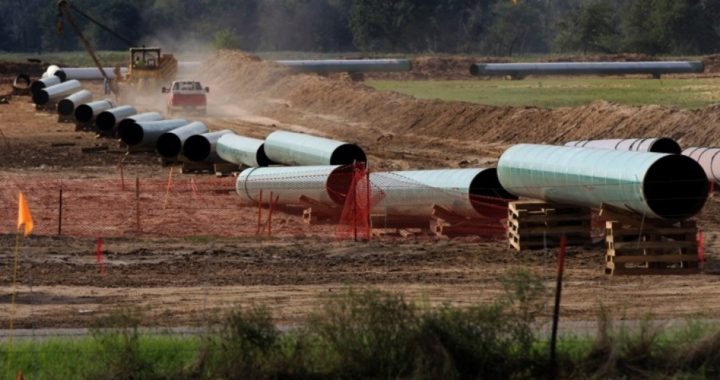
In the first major vote in the House during the current lame duck session, on Friday a bill to approve the Keystone XL Pipeline passed by a vote of 252-161. In an ironic twist, the bill — the ninth one approving Keystone — was sponsored by Rep. Bill Cassidy, the Louisiana Republican facing Democrat Senator Mary Landrieu in a runoff election on December 6. Landrieu has been moving heaven and earth in the Senate to approve Keystone in an attempt to salvage her career.
Said Cassidy:
Here we are on the ninth attempt. It has been 539 days, about a year and a half, since the House first sent a Keystone approval bill to the Senate in this Congress. We are going to make it as easy as possible for the Senate to finally get a bill to president’s desk.
And there it will die, if it makes it that far, as President Obama has repeatedly stated. Which raises the question: Why bother?
After all, the highly volatile Keystone pipeline about which environmentalists are all in a dither is merely the fourth leg of the pipeline. The other three legs have been in operation for years, bringing crude from North Dakota to refineries on the Gulf coast. If approved, it would take three years to complete, cost upwards of $10 billion, and increase its capacity only by a little over 800,000 barrels per day. This compares to the nine million barrels per day already gushing from oil shale formations ranging from North Dakota to Texas. At present growth rates in the oil patches, Keystone would carry far less than 10 percent of all crude oil being produced by 2018.
Canadian companies saw the potential for delay years ago and began planning various workarounds, including building pipelines to the east coast — Energy East — as well as proposed pipelines taking oil sands from Hardisty (across the border from North Dakota beneath the Bakken formation) in Alberta, Canada, to the west coast. As Canadian Ambassador Gary Doer said back in July, 2013:
[Obama’s] choice is to have it come down by a pipeline that he approves, or without his approval, it comes down on trains. That’s just the raw common sense of this thing…. At the end of the day, it’s trains or pipelines.
Even though trains are more costly to ship the thousands of barrels of oil being produced from the Bakken formation, there are numerous advantages that are making them an attractive and perhaps permanent alternative to pipelines. As Ethan Bellamy, an analyst at investment firm Robert W. Baird, inelegantly but clearly put it, “Making a pipeline volume commitment is like getting married. Shipping by rail is like a one-night stand. Right now I suspect producers would rather stay bachelors.”
For instance, low sulfur content crude from Bakken is highly prized at east coast refineries, and therefore is more profitable for producers than the Texas refineries now served by present pipelines. Tad True, vice president of True Companies, an oil pipeline operator in North Dakota and Wyoming, said the trains can reach refineries that pipelines can’t. Because of that, he estimates that new oil pipeline construction will only be to tie to railheads the network of the more than 200,000 miles of pipelines that already exist, to make the whole system more efficient.
Enbridge Inc. doesn’t need Keystone. It is building its Northern Gateway Pipeline project to carry natural gas condensate eastward to markets on the east coast while simultaneously (using a double pipeline) carrying oil sands from Alberta to Kitimat, British Columbia, where it will be shipped to Asian refineries for processing. It is also building a new line, with the help of Marathon Petroleum Corporation, that will carry crude out of North Dakota to refineries in Michigan and Kentucky, starting in 2016.
Kinder-Morgan’s Trans-Mountain pipeline already delivers 300,000 barrels of crude every day from Alberta to Vancouver, B.C., and is seeking approval from Canadian authorities to nearly triple that with an expansion.
Although rail is more costly than pipeline transmission, it is almost as safe, despite the headlines that the 2013 Lac-Megantic tragedy generated. This was confirmed by Obama-appointed Federal Railroad Administrator Joseph Szabo:
Rail has never been safer. I have said repeatedly, 2012 — by virtually all measures — was the safest year in railroading history, with train accidents down a remarkable 43% in 10 years. And among the millions of annual shipments of hazardous materials by rail, less than a fraction of 1% of these has resulted in any type of release.
The passage by the House of its ninth attempt to force the Senate to send a bill approving Keystone to the president’s desk for signing will surely fail once again. The longer Obama waits, the less relevant Keystone becomes — as does the president himself.
Photo of Keystone XL pipeline section in Texas: AP Images
A graduate of Cornell University and a former investment advisor, Bob is a regular contributor to The New American magazine and blogs frequently at www.LightFromTheRight.com, primarily on economics and politics.
Related article:



